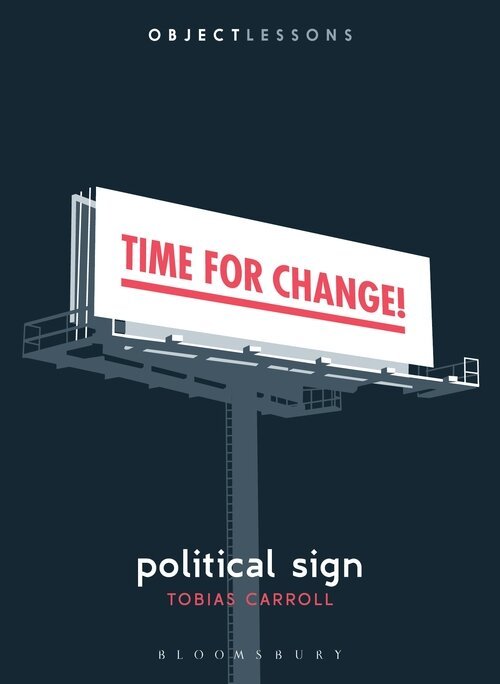What makes something a political sign?
Tobias Carroll | Political Sign | Bloomsbury Academic | September 3 2020 | 192 Pages
Just what makes something a political sign? That was one of the questions I set out to answer when researching and writing the book Political Sign. I began with the obvious choices—yard signs, billboards, and bumper stickers—but soon began to consider deeper questions. If an artist paints a political sign in a painting, is it still a political sign? Would Roger Stone’s infamous Richard Nixon back tattoo qualify? As I went deeper and deeper into the historical record, something became clear: under the right circumstances, nearly anything could be a political sign.
Having said all that, though, I really wasn’t expecting to see face masks act as a kind of political sign for American politicians and voters alike in 2020.
Some face masks, clearly, fit the bill; while driving around my neighborhood the other day, I saw someone sporting a facemask on which the phrase “DEFUND POLICE” had been printed. One of the narratives of the ongoing pandemic has, tragically, been about people refusing to wear face masks as a political stance in and of itself. Hardly a week goes by without a video of someone loudly throwing a tantrum when told they can’t enter a store without a face covering of some kind.
Unfortunately, wearing (or not wearing) a mask can fall along partisan lines. A recent Pew Research study noted that 92% of Democrats and people who leaned towards the Democratic Party were wearing masks regularly, compared with 76% of Republicans and people who lean Republican. Both numbers were way up from earlier in the year, which is a good thing—but the gap between the two isn’t small.
At a time in which Donald Trump himself has been relatively laissez-faire when it comes to mask-wearing—including telling guests at an indoor event at his Bedminster golf club that they didn’t need masks—it ends up reading as largely partisan. Are there conservatives who are also dedicated mask-wearers? Absolutely. But wearing a mask—and, perhaps more so, not wearing a mask—can feel like a partisan or ideological declaration.
That’s not even touching the odd phenomenon of “mask exemption cards,” which cite the Americans With Disabilities Act and come from a faux federal agency but are not, in fact, real. Here, too, it’s a case of political signage with an ideological bent—specifically, the tendency among some conservatives to endeavor to flip the language of accessibility around so that it can be used for a very different agenda.
You might think that most political signage used during crises like the current pandemic would exist in a more apolitical form, working to improve public health and well-being rather than advancing a partisan agenda. But from politically-charged masklessness to Donald Trump delaying stimulus checks so that his signature could be on them, this crisis has abounded with partisan political signage. More unnervingly, it’s far from the only disaster where relief pulled double duty as political signs.
When researching Political Sign, I came upon news reports from the aftermath of Super Typhoon Haiyan, which killed thousands in the Philippines in late 2013. A CNN report from November of that year laid out a growing trend: disaster relief supplies bearing the logos of different politicians—assumably, seeking votes from affected citizens along with the bump in publicity that would come from being associated with providing relief in the wake of such a tragedy. CNN’s article, by Christina Zdanowicz and Katie Hunt, explored conflicting reports over the nature of some of the supplies and offered a surprisingly relevant examination of how that sort of signage might work.
Is there much of a difference between a bag full of disaster relief supplies bearing the name and face of a politician and a disaster relief check prominently featuring the name of a politician running for re-election that same year? The two are not terribly far removed from one another.
2020 has been an election year like few before it, and the political signage related to the election appears in forms both familiar and new. (As of this writing, both the Trump and Biden campaigns are selling face masks emblazoned with their candidate’s logo.) Earlier this year, I bought a t-shirt featuring the Postal Service mascot Mr. Zip. What might have seemed like a knowingly retro gesture in other years suddenly feels politically charged in this one. What can be a political sign? Under the right conditions, virtually anything—including the memo on a check or the absence of a mask.
If you enjoyed this piece, please consider making a donation.

